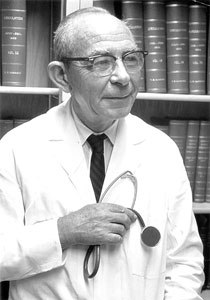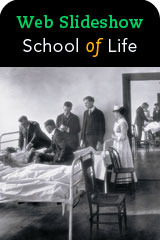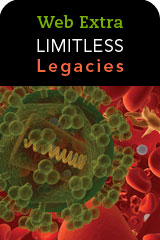Legendary Visions for Cardiovascular Care
By Doug Gillett
Birmingham was known for steel and segregation in 1950 and 1966, when Tinsley Harrison, M.D., and John Kirklin, M.D., came to town. But their arrivals would soon elevate the city’s medical center to the world stage with the development of a highly respected cardiovascular program and breakthrough methods of teaching and treatment that continue to shape health care today.
Rethinking the Principles
 |
Talladega native Tinsley Harrison helped lead the medical school and its cardiovascular program to national prominence. Photo courtesy of UAB Archives. |
In a sense, anyone who has seen a physician in the last half-century has been treated by Tinsley Harrison. The year he came to the Medical College of Alabama to serve as the Department of Medicine’s first full-time chair, he published a textbook, now known as Harrison’s Principles of Internal Medicine, that revolutionized the way students learned to diagnose patients. The book categorized symptoms before diseases, following the logical path most physicians take when studying and diagnosing cases. Today the acclaimed volume is one of the world’s most widely used medical texts, with translations in 14 languages.
The book helped cement Harrison’s reputation as one of America’s most important clinicians and medical educators. Wayne Finley, M.D., a graduate student and medical student during Harrison’s final years who later pioneered medical genetics at the school, remembers the lasting impression Harrison made.
“His presence on campus had a magnetism about it,” Finley recalls. “He was a real showman when he was teaching, and everybody had great respect for him. He basically started the research program here, and he was also noted for his patient care. He had patients referred to him from all over.”
A Rising Star
Together with Champ Lyons, M.D., Harrison made a major push to expand and strengthen the medical school, particularly in the area of cardiovascular medicine. Even after Harrison stepped down as chair of medicine, the school was recruiting full-time faculty from elite institutions such as Harvard University and the Mayo Clinic—including John Kirklin, M.D., who succeeded Lyons as chair of surgery in 1966.
 |
John Kirklin (at left) shaped modern cardiovascular surgery through his refinements of tools and techniques. Photo courtesy of UAB Archives. |
“No one thought they could recruit Kirklin, because he was such a rising star,” Finley says. “He was head of surgery at Mayo, and his father had been a physician there.” Kirklin was invited to serve as a consultant, and once he had studied the surgery department and submitted a plan, the school encouraged him to take charge of implementing it, Finley explains.
“I remember the day he came to campus. Everyone was excited—they knew this big name was coming—and it was really a transformation. His presence was felt throughout, and still is.”
Kirklin was a trendsetter—at Mayo, he had made innovative refinements to the heart-lung machine—and continued to break new ground in Birmingham. He created the first intensive-care unit to use continuous patient monitoring, now standard practice worldwide, and established UAB’s reputation for complex cardiac surgeries. In evidence-based practice and outcomes research, “John Kirklin’s research made a huge impact on care delivery and improving the outcomes that he was studying,” says Robert C. Bourge, M.D., director of the Division of Cardiovascular Disease and the Mary Gertrude Waters Chair of Cardiovascular Medicine.
Bourge says he was inspired by Kirklin’s research to develop the Cardiac Transplant Research Database (CTRD) in 1989 with Jim Kirklin, M.D., John’s son, and David Naftel, Ph.D. Based largely on John Kirklin’s data collections and registries, the CTRD was the first large-scale multicenter compilation of cardiac-transplant recipients to be studied in any detail, Bourge says.
Today the Division of Cardiovascular Disease numbers 62 faculty in 10 sections and recently initiated the UAB Center for Cardiovascular Biology. The division’s many accomplishments have led U.S. News and World Report to name UAB among America’s top cardiovascular centers—and they all owe a debt to the groundwork laid by Harrison and Kirklin.
“That’s what made this place at the time,” Finley remembers. “They made all the difference in the world.”

